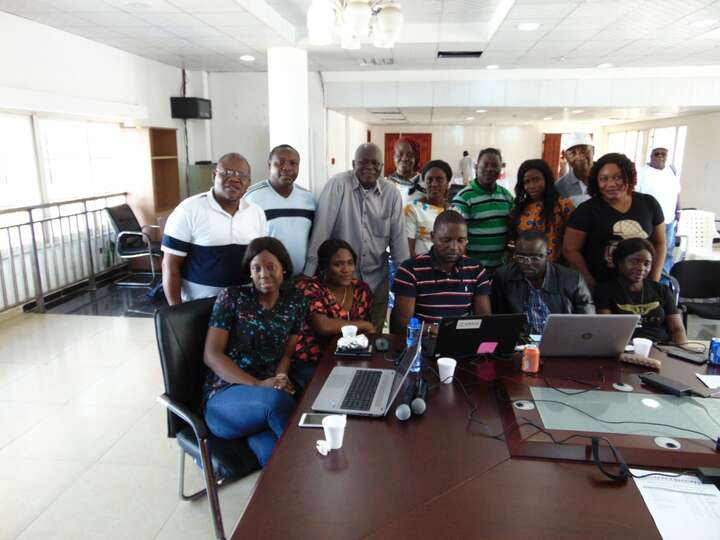
Alice Perkins, Research Manager COUNTDOWN Liberia, Laura Dean, Georgina Zawolo, Anthony Bettee, Karsor Kollie and Sally Theobald
COUNTDOWN is a multi-disciplinary partnership formed in 2014 following a grant from the UK Department for International Development (DFID). The programme is focused on conducting research on improved ways to support the scale-up of interventions in sub-Saharan Africa against neglected tropical diseases (NTDs). In Liberia, COUNTDOWN is partnering with the Ministry of Health & University of Liberia – Pacific Institute of Research and Evaluation (ULPIRE) to carry out implementation research to strengthen NTD Programme activities.
During the COUNTDOWN launch in Liberia, the partners set as an objective, to look at current NTD policies relating to NTDs and consider opportunities for those policies to influence the NTD Programme more positively. Against this background, preliminary results from COUNTDOWN implementation research conducted in Bong and Maryland Counties, revealed gaps and challenges in programme delivery. Early findings emphasized a lack of awareness amongst communities in relation to the NTD programme. Consequently, through discussion with the NTD programme manager and other stakeholders, it was decided that the NTD programme needed a specific communication’s strategy to ensure targeted awareness activities reach all members of the population.
With support from COUNTDOWN, the NTD Programme joined with the National Health Promotion Department to develop a communications strategy. The National Health Promotion Department seemed the logical choice for this collaboration given their expertise in the development and roll-out of communication campaigns related to diseases of public health importance in Liberia. Together, the departments developed targeted messages and clear communication aims that will lead to effective advocacy. They also developed Social Behaviour Change Communication (SBCC) materials to address awareness, uptake, and acceptance of the NTD programme at the county level and below. This is the first time that the NTD Programme and the National Health Promotion Department have collaborated on a communications initiative.
The iterative process involved a series of meetings with different partners involved in NTD programmes. A pre-meeting with the Health Promotion Department and the NTDs Programme was held to develop an outline of the document. The largest meeting, which was a key meeting with partners and stakeholders in Buchanan between 4th – 5th December 2017 where technical content was developed and expanded. Following a series of document reviews and refinements, a validation meeting was held on 19th September 2018 in Monrovia. The Communication’s Strategy is being finalized based on the input offered in the validation meeting. Once it is signed off by the Ministry of Health, the NTD Communication’s Strategy will become an addendum to the National Health Promotion Communication Strategy.
Based on our experience supporting the development of the communication strategy, we can share reflections about how underlying social and political factors shaped the ability of two departments in the Ministry of Health, the NTD Programme and the National Health Promotion Department to collaborate. The narrative is based on participants’ observation of the collaborative process for policy. Through individual and group reflections on the policy development process (which we were a part of), we discovered how different strategies for partnership-building could support health systems to galvanize expertise from within to develop new and innovative strategies for collaborative action.
The strength of the collaborative process in Liberia included merging of technical expertise (from National Health Promotion, NTD programme, Ministry of Education, Ministry of Agriculture and partners - Sightsavers, Partnership for Advancing Community-Base services [PACs]) to generate appropriate messaging for target audiences. It was a unique opportunity for different governmental departments to gain knowledge and share ideas leading to increased availability of and access to evidence, resources, and data.
We also observed that some factors, if not anticipated and mitigated, threaten the success of intersectoral collaboration. Potential threats and some ways to combat them are presented below:
- Cross purposes of expertise and tendency to prioritize own discipline/specialist area: Members of each group must have faith that others’ contributions to the process are just as reliable and reasonable as their own. Collaborators with different expertise bring different interests that strengthen the process of strategy development.
- Collaboration lasting too long: The duration of the collaborative process and even the length of a single meeting must be sufficiently short to facilitate participation by professionals who are already overburdened. Discussion on a particular topic must be contained, and the participants must be focused on efficiently reaching consensus and concluding.
- Funding constraints challenge collaboration. Despite goodwill of different departments and willingness to actively participate, limited funding can constrain the amount of time available to complete the work. Leaders of the policy-making process must be realistic and advocate for sufficient funding to support a robust collaborative process.
- Research data can be insufficient to shape the process: When content there is no baseline data or previous policy documents to build upon, then extra time must be built into the process to gather critical information and prepare new documents to serve as resources.
- Communication breakdown once one party is satisfied with the end-product: Participants must be committed to the entire process, remaining involved beyond the point when their own priorities are addressed. They must stay engaged and support other ideas presented by their counterparts.
Collaboration amongst representatives from different disease programmes and disciplines gives a rich opportunity to support health systems development by addressing diverse challenges across varying contexts. By sharing our thoughts on what helps and hinders collaborative practice within the health sector, we aim to contribute toward new mechanisms of governance that support coherent action on health challenges. Future collaborative activities may wish to promote shared agenda setting, including timelines, budgets, activity roles and deadlines; invest time in relationship building and setting up trust between the collaborating teams; and ensure that enough time and resources are provided to continue monitoring and revisions to products until they reach successful completion.
